The Sultans of Sweet. Learning about matching Residual Sugar in Mosel Riesling with food
Sweet wine is evil. Just mentioning it can make people's faces go grumpy bulldog on you. Even the faces of those who haven't tried any yet. Wine with residual sugar is often seen as nasty plonk, suitable for a cheap hangover or perhaps as a wine for the ladies, and that is usually not meant as a compliment either. In the UK, it is particularly associated with Germany 'thanks' to brands such as Liebfraumilch.
So I have to deal with a lot of bulldog faces in my mission to interest people in German wine. The most successful approach, I find, is to get them to taste the wines, especially with food, but that is a slow process if you are just one guy with a wardrobe full of Riesling in a nation of millions of wine drinkers.
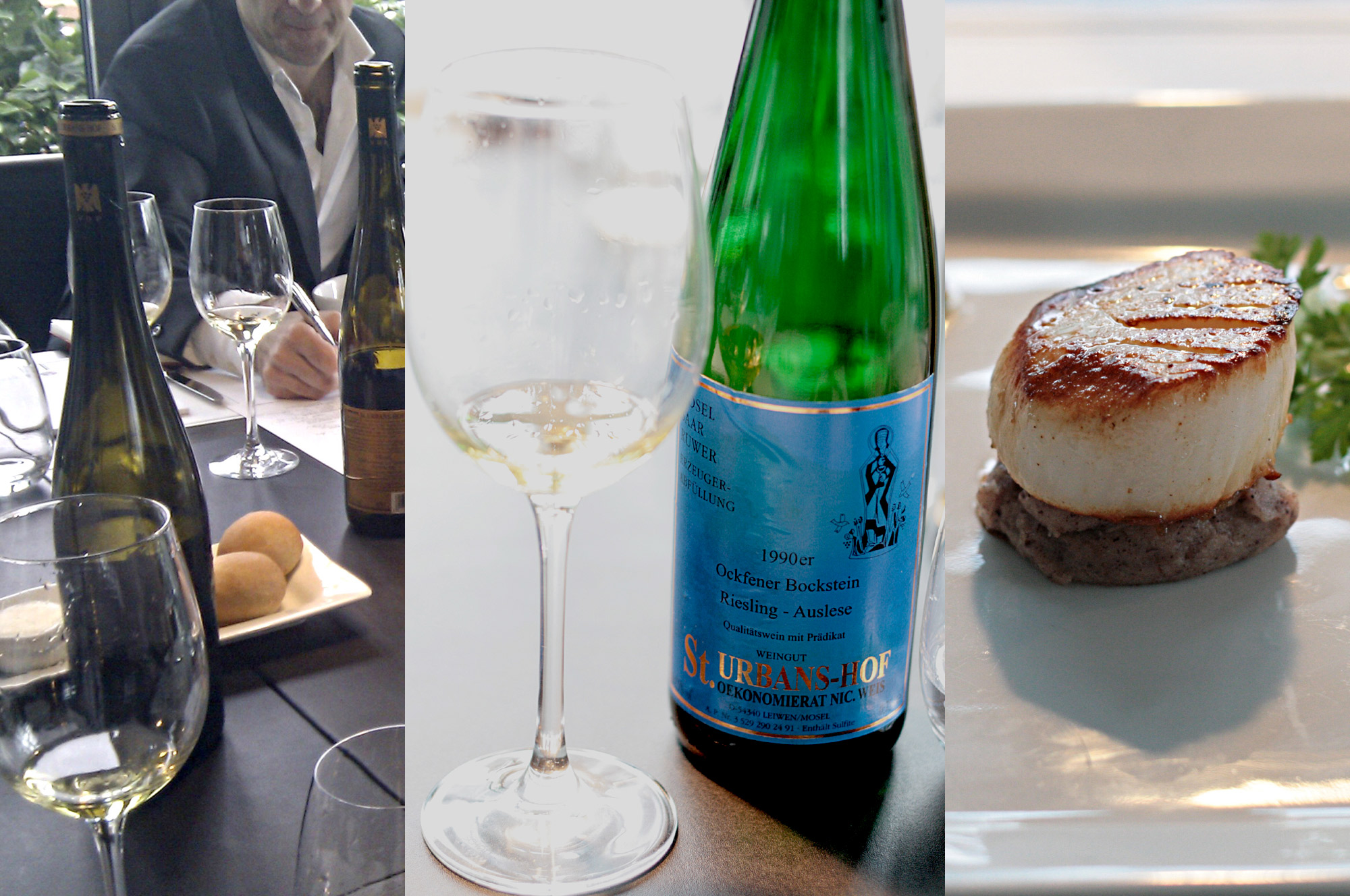
So imagine my delight when I was recently invited to a lunch workshop designed to explore how off-dry and sweet Rieslings pair with food: Who is afraid of Residual Sugar? was organised by St. Urbans-Hof, one of the premier Mosel estates. What started as a very exciting and tasty experiment turned into a far-reaching discussion on the world of wine, customer perception, national (wine)stereotypes and wine marketing.
Who is afraid of Residual Sugar? A St. Urbans-Hof lunch workshop
The set-up of the workshop was quite unusual. Nik Weis, owner of St. Urbans-Hof, had invited a panel of sommeliers, winebuyers and writers to explore pairing his wines with different dishes. The panel consisted of:
- Chris Osburn, food and drink editor, Londonist
- Christine Parkinson, group wine buyer, Hakkasan, and her colleague James*
- Ilya Fatthakov, head chef, Eight Members Club
- Laurent Chaniac, wine buyer, The Cinnamon Club
- Nic Weis, owner St Urbans-Hof
- Robert McIntosh, brand ambassador, Wine Conversation
- Walter Speller, Walter Speller Consultancy (organiser of the workshop)
- yours truly
Instead of presenting us with a fixed menu, the organisers had sent us a list of the wines, with details on alcohol, acidity and residual sugar levels, and asked us to make suggestions. Based on those, Ilya Fatthakov, head chef of the Eight EC2 members club, where the workshop took place, created six courses for us to work with (however, he chickened out of trying my suggestion of lamb on a spicy tomato purée - trust me, it can be delightful with the right Riesling):
- Chevice of tuna with samphire and lemon oil
lightly seasoned loin of yellow fin tuna, seared + with samphire blanched for 30 seconds + dressed in lemon olive oil - Smoked trout
smoked trout + cucumber pickled in weak solution of white wine vinegar, sugar and star anise + beetroot + garnished with fresh grated horseradish - Rosti with scallop and black pudding
seared scallops + potato rosti + black pudding mash + garnished with chervil - Squid millefeuille
pan-fried baby squid with garlic and chilli + crispy salami + salad of herbs and mint + honey and lime sauce - Pork loin
seared loin of pork + curried celeriac + apple rhubarb compote - Époisses crouton
époisse + toasted ciabata + truffled honey
While we perused the nicely printed menu and sampled the wines, Nik introduced us to Mosel Riesling in general and to St. Urbans-Hof in particular (I had cunningly kept the fact a secret that I had actually visited the winery in 2008).

The estate was established in 1947 by Nik's grandfather and has since grown to 33 ha – almost a giant in a region where many estates own just a few hectare. On St. Urbans-Hof's slatey vineyards along the Mosel and Saar rivers Riesling is grown exclusively. Nik champions a quality focussed style of production that is defined by traditional and natural methods, including organic fertilisation, hand picking of grapes and natural fermentation. 'By cultivating it', Nik explained, 'you make the soil alive.' The goal is to produce first rate wines that embody what is best about the region and the respective vineyard.
We tried six wines from the St. Urbans-Hof portfolio. They ranged from the 'basic' 2009 Urban Riesling to a premier sweet wine, a 1990 Auslese. The only dry wine was the 2009 Grand Cru Riesling from the Leiwener Laurentiuslay.
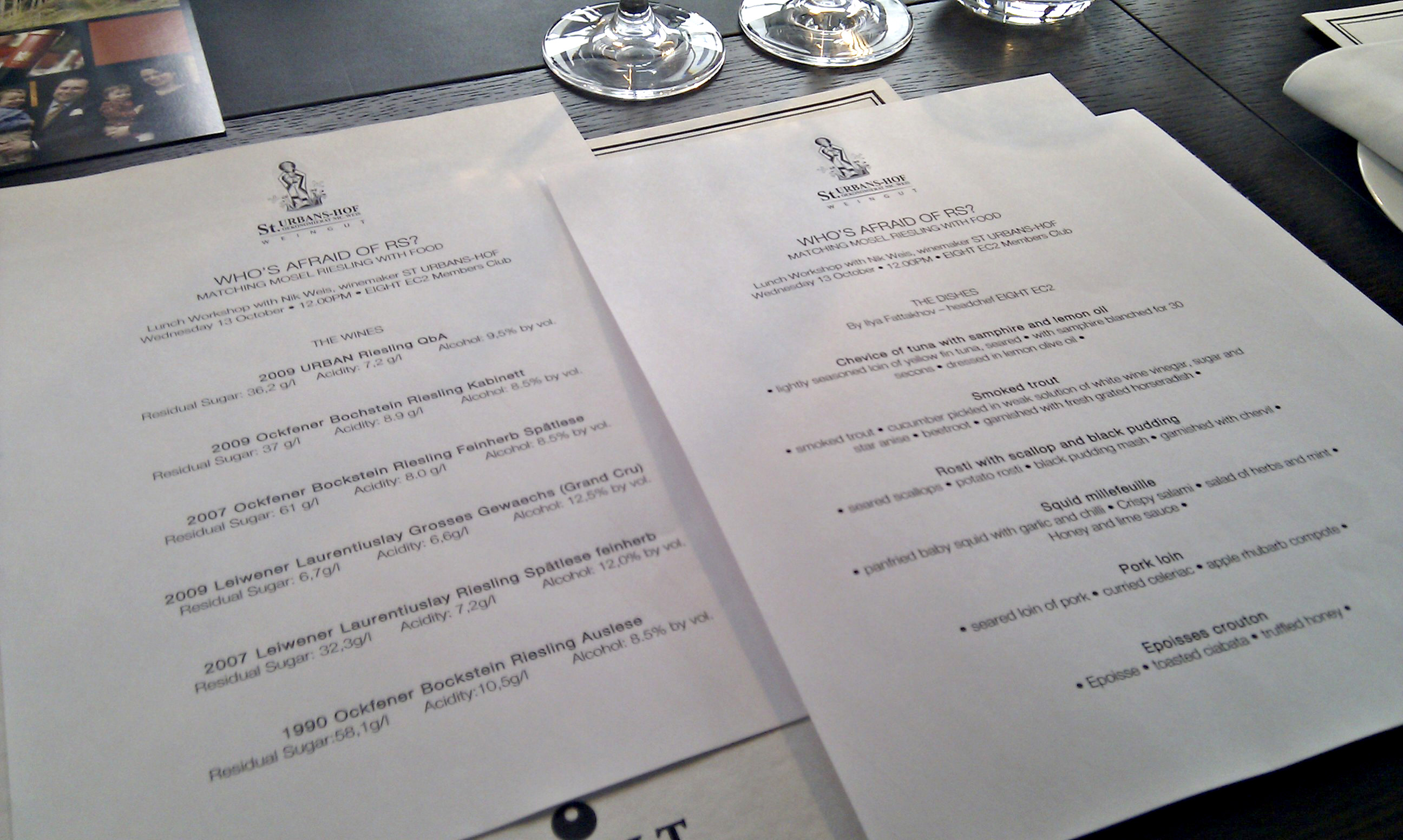
There is not enough space to give a detailed review, but let me just say that the quality was very high, with the 1990 Auslese a particularly good example of the excellent balance a good Riesling can achieve with age.
- 2009 Urban Riesling QbA (alcohol: 9.5% by vol.; acidity: 7.2 g/l; residual sugar: 36.2 g/l; £9.99***)
- 2009 Ockfener Bockstein Riesling Kabinett (alcohol: 8.5% by vol.; acidity: 8.9 g/l; residual sugar: 37 g/l; £13.30)
- 2007 Ockfener Bockstein Riesling Feinherb Spätlese (alcohol: 8.5% by vol.; acidity: 8.0 g/l; residual sugar: 61 g/l; £19.80)
- 2009 Leiwener Laurentiuslay Großes Gewächs (Grand Cru) (alcohol: 12,5% by vol.; acidity: 6,6g/l; residual sugar: 6.7g/l; £25.99)
- 2007 Leiwener Laurentiuslay Riesling Spätlese feinherb (alcohol: 12,0%; by vol.; acidity: 7,2g/l; residual sugar: 32.3g/l; £25.99)
- 1990 Ockfener Bockstein Riesling Auslese (alcohol: 8.5% by vol.; acidity: 10,5 g/l; residual sugar: 58,1 g/l; £48.16)
After Nik's introduction, the food arrived. We were free to pair each dish with as many wines as we wanted, and after each course we compared our impressions. Initially, we talked a lot about the individual pairings, but after a while the discussion moved on to the wider topic of perception of wine and wine marketing.
Themes, topics, lessons
Have a little faith – Residual sugar and the balance of wine
What I am going to say now seems almost pointless. If you have tried a good sweet wine, well, you will already know, and if you haven't, well, you may not believe me anyway. I can only ask for a leap of faith here.
It really doesn't matter whether a wine is sweet or not. Seriously, you would expect us to have focussed on sweetness in a workshop on residual sugar and Mosel Riesling, but we didn't. For the panel, sweetness was one of several components in the wines. When all components are well balanced, the wine is in harmony. It was this harmony we were looking for, and the St. Urbans-Hof wines clearly have it.
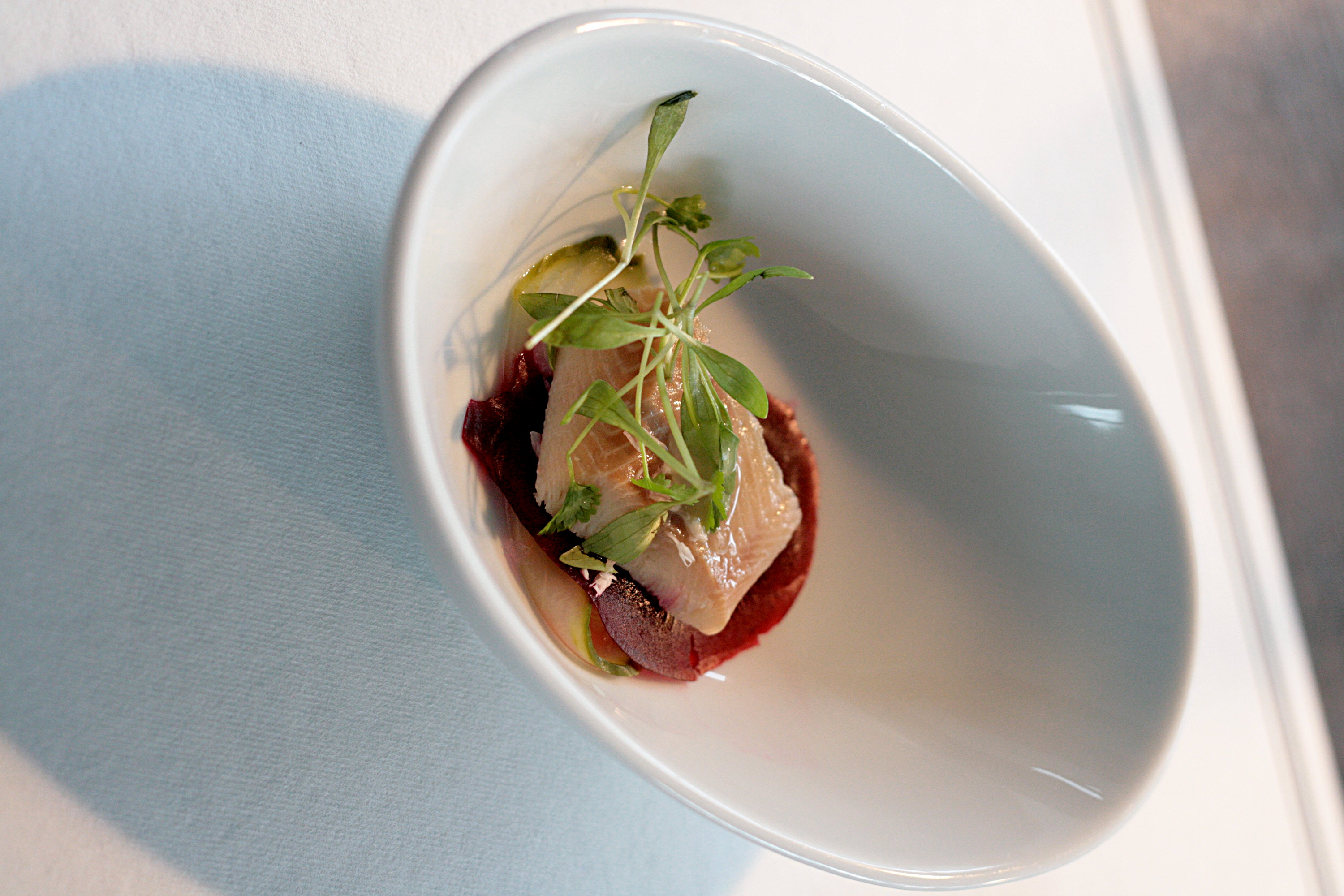
Instead of the objective sugar content it is the balance between aspects such as acidity, age and minerality that determines whether a wine is perceived as sweet or not. My favourite wine for instance, the 1990 Auslese, had tooth-melting 58 gram of residual sugar per litre, but because of the high acidity and almost two decades of ageing it did not feel overly sweet. In fact I would claim that if you let the infamous 'average customer' taste it against the Urban Riesling they would probably think it was the drier wine.
Interestingly, the bureaucratic German wine law acknowledges this to a certain extent. Wine can only be labelled as 'trocken' (dry) with up to 4 g/l of residual sugar – or up to 9 g/l if the acidity level is relatively high.
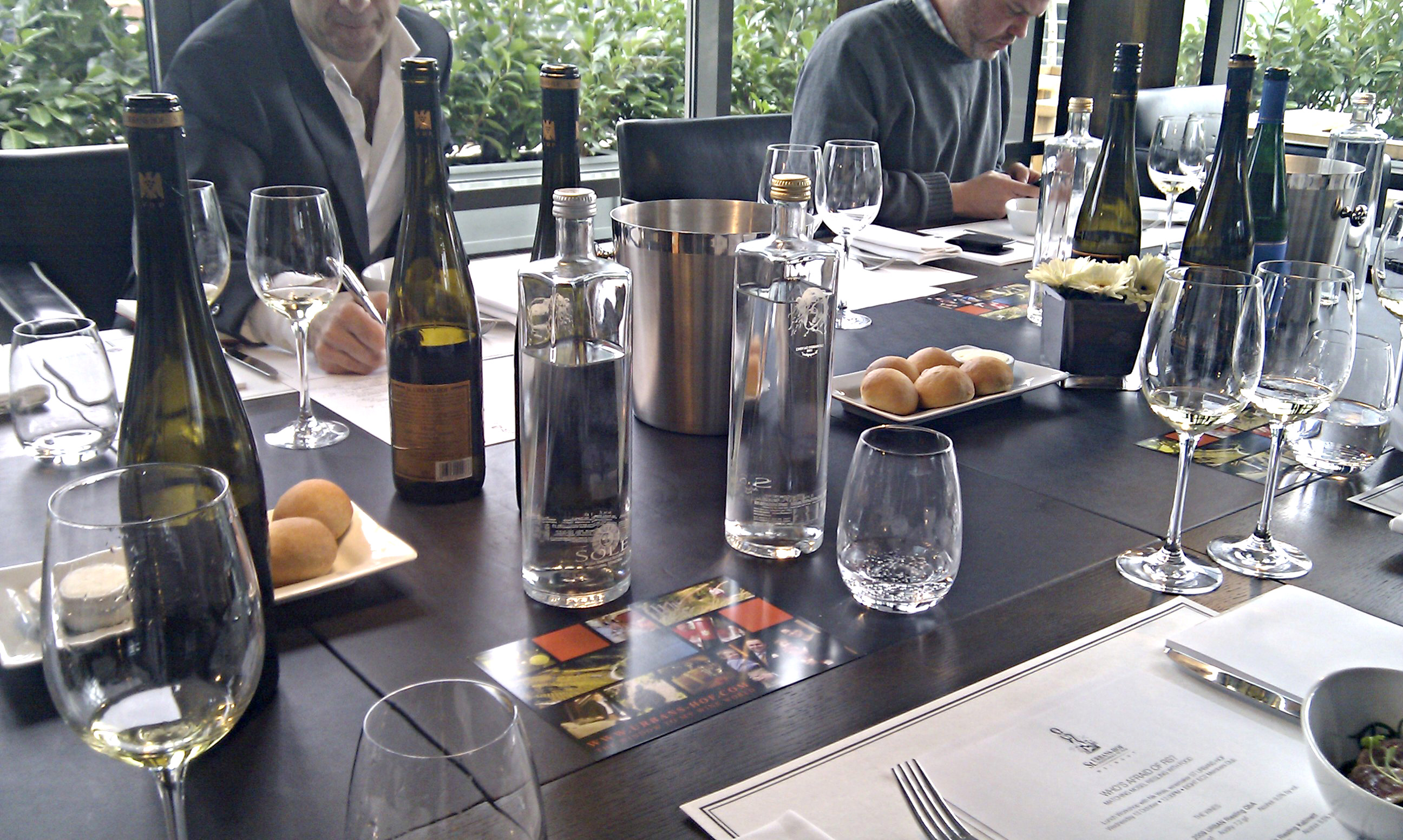
So if there is one lesson to be had here: buy good wine, no matter whether it is sweet or dry. And to be more specific: trust Mosel Riesling, even if you are not overly keen on heavier dessert wines. With their higher levels of acidity good Mosel wines should never be overwhelmingly sweet – but well balanced.
Sweet is beautiful - Residual sugar and food pairing
If you are still with me after lesson number one, there is a chance you may believe lesson number two: off-dry and sweet Mosel Riesling can pair very well with food.
Towards the end of our tasting experiment, Walter said that he had hoped for at least one food and wine pairing where the sweeter wines would be seen as a disastrous match. Hard as we tried we could not please him there. There was not a single dish to which not at least one or two panel members preferred one of the sweeter wines as match. In fact, the wines with higher RS did overall fair better than the dry Grand Cru Riesling.
This may seem a little odd, after all there is a school of wine and food matching that would usually recommend drier white wines (with the exception of dessert and dishes such as foie grass perhaps). However, in our case there was only one dish for which more than one panel member strongly endorsed the dry Grand Cru Riesling: the rosti. Robert liked the wine's relative dryness as a contrast to the sweet element in the dish, and I found the food pleasantly enhancing the texture of the Riesling. The others had looked for sweetness to match the dish, although James felt no wine was a perfect match because of the roast flavours of the food.
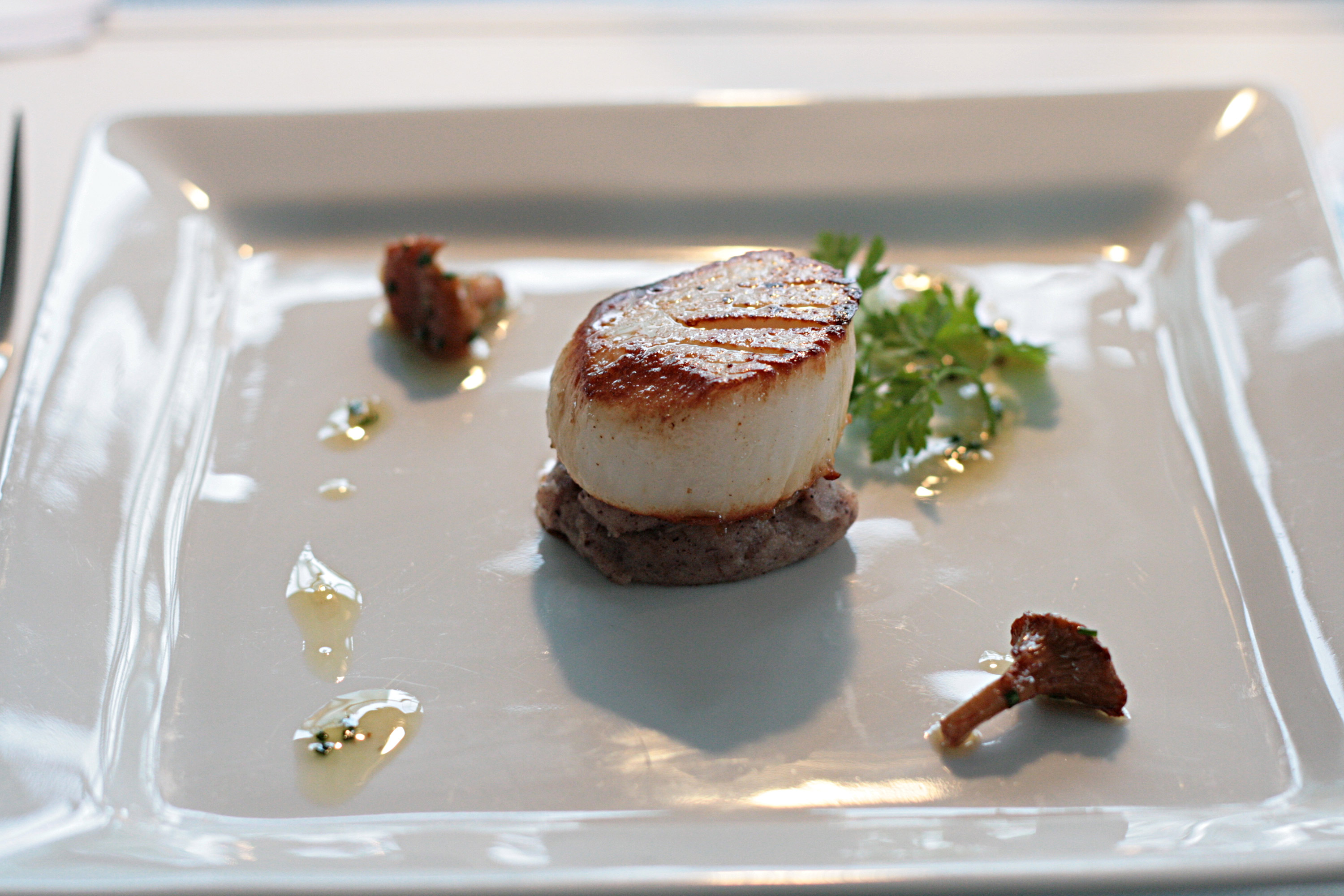
A classic match for sweeter wines is spicy food, and so it may not come as a surprise that we felt that the squid went extremely well with wines with higher RS. Christine tried the dry Grand Cru and said that it 'nearly worked' because of its elegance and vibrancy, but the chilli made the wine’s fruit taste unpleasantly green. Those of us who did actually bite the chilli, including me, really appreciated the sweeter wines.
Wisdom of Age - Aged Riesling and food
The squid with its chilli heat also showed the limits of an otherwise incredibly versatile wine: the almost 20 year old Riesling Auslese. Again and again this wine demonstrated why good Rieslings can be wonderfully versatile food matches. With age, the sweetness slowly recedes, different components integrate. Acidity, sweetness, fruit, they are all still there, but in a more smooth, well rounded way, such as in a pebble that has been in a stream for years. Still rock, still hard, but ever so soft on the outside. For matching with food, you can emphasise the various elements as needed, but they feel less intense than in the wine's youth thus reducing the risk of overpowering a dish. The lower level of alcohol in sweeter Riesling is a welcome bonus.
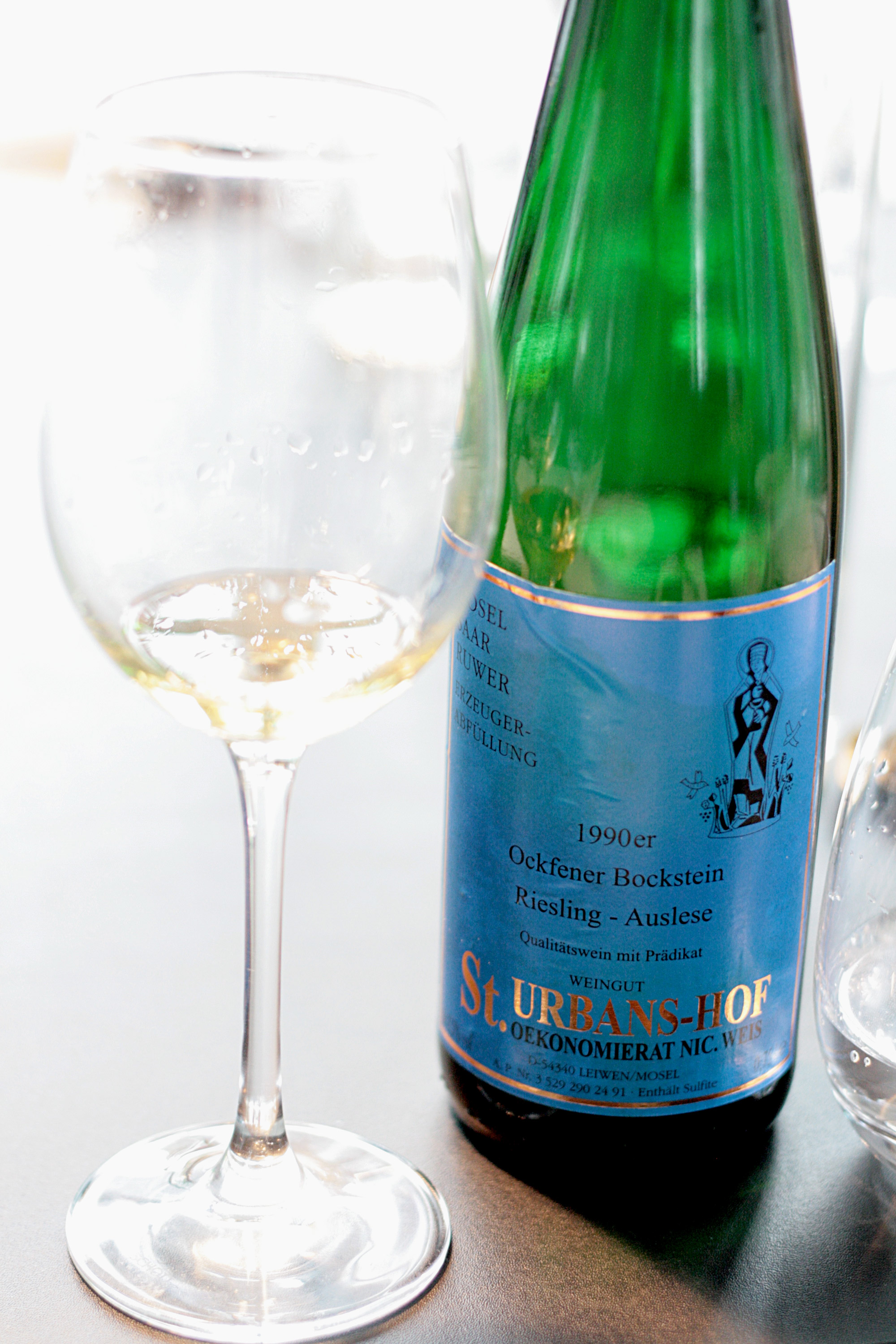
In addition to that, the 1990 Ockfener Bockstein had great complexity that worked extremely well with some of the dishes. It was my first pick to go with the trout, where the strong minerality of the wine proved a marvellous match to the smoky flavours of the fish, with just the right addition of sweet and fruit. The hot chilli of the squid though robbed the wine of some of its complexity - not necessarily a bad thing if your focus is mostly on the food, but this was a match that for some panel members made the wine shine a little less. The opposite happened with the pork loin, where the Auslese's complexity almost overpowered the food.
An aged Riesling can be a perfect match for a wide range of dishes, but it will not work at all in some scenarios. What a wine though!
A Modest Workhorse – The winner of the day
Interestingly though, there was a wine that went well with pretty much every dish: the modest Urban Riesling, the cheapest wine of the day. To a certain extent, this was exactly because of it being such a modest wine. The alcohol level is pleasantly low and the residual sugar is relatively high, yet somewhere in the middle between the extremes – sweet enough to go with the dishes that needed RS but not too sweet for others. The wine lacked some of the depth and complexity of the other Rieslings, but that was what made it such a good all-rounder as there was less chance for it to clash with the dishes.
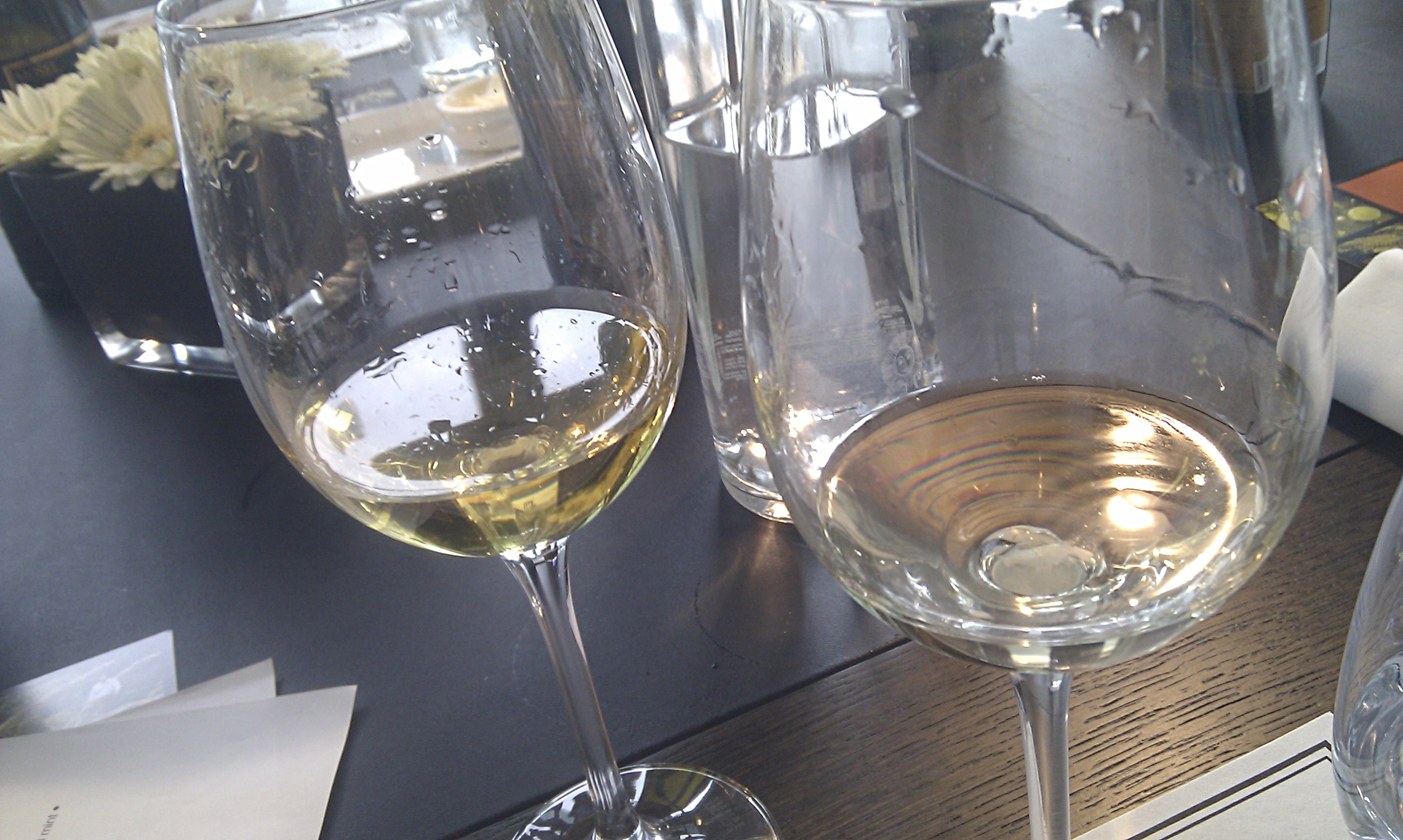
For pretty much every dish there was a wine that worked better than the Urban, but there also was no wine that overall did so well. As Christine put it: 'It has a lot of everything, but of nothing too much.'
A Quest for Certainty - Principles, but no guarantees
Leaving more general aspects of food and wine pairing (such as RS with spicy food) aside, our recommendation for the Urban Riesling was one of the few specific pairing suggestions we all agreed upon.
When it came to the pork loin, for instance, there was a general consensus that the acidity in the Auslese overpowered the dish, but no clear consensus emerged which wine was ideal. Again, the 2007 Laurentiuslay worked for some of us, but the sour component of the apple was not easy to match. With the driest wine I did reasonably well here, but that may have been due to personal preference.
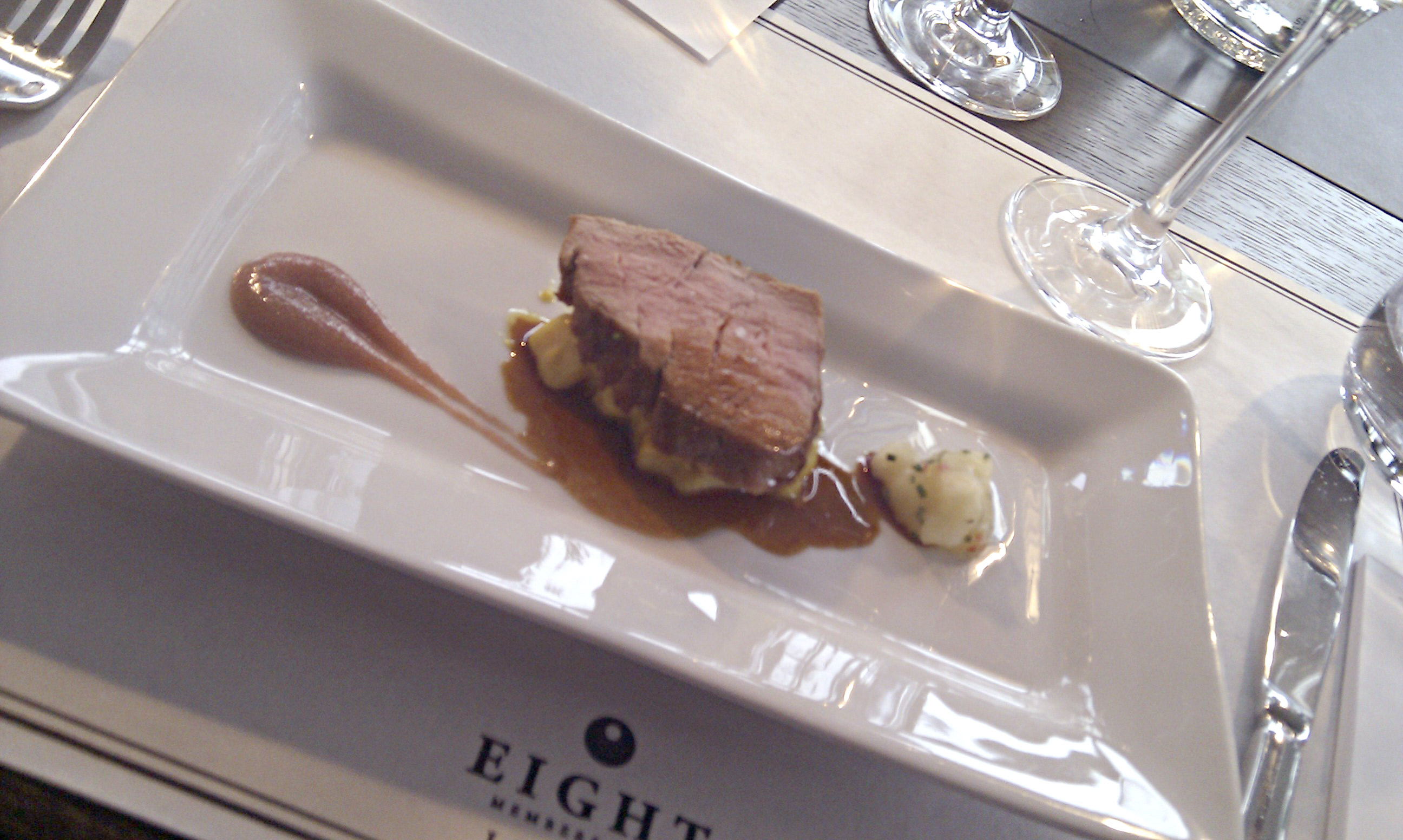
For the smoked trout, the 1990 Auslese was a clear winner, but Christine wanted more fruit to match the dish. We also fought a lot over the coriander in the dish. Laurent argued that coriander in his experience did not go too well with drier white wines, but on this instance the sweeter ones also let him down. Chris and I agreed that the Auslese really emphasised the coriander, but not so much on whether this was a good thing. Even the effect of the chilli was not the same on all our palates: for Robert it broke the complexity of the Auslese Riesling, whereas Laurent approved of the match.
Contrast or Complement
Perhaps some of the different recommendations for food and wine pairings are down to the fact that two different methods were used for matching: complementing versus contrasting. Using the first approach, one looks for certain elements in a dish and then finds a wine that is similar, to create harmony. The other approach, going for contrasts, is a little more radical. In my experience, it creates the most interesting pairings, but it is also much more risky in that it can go really wrong.
For the contrast approach it is also important to consider the respective dish. When it came to the squid millefeuille, for instance, some panel members made that point that the food had already so much contrast that adding more through the wine would be confusing - this is why the Urban Riesling did quite well here, especially with its moderately high RS level that brought some relief for the chilli-biters amongst us.
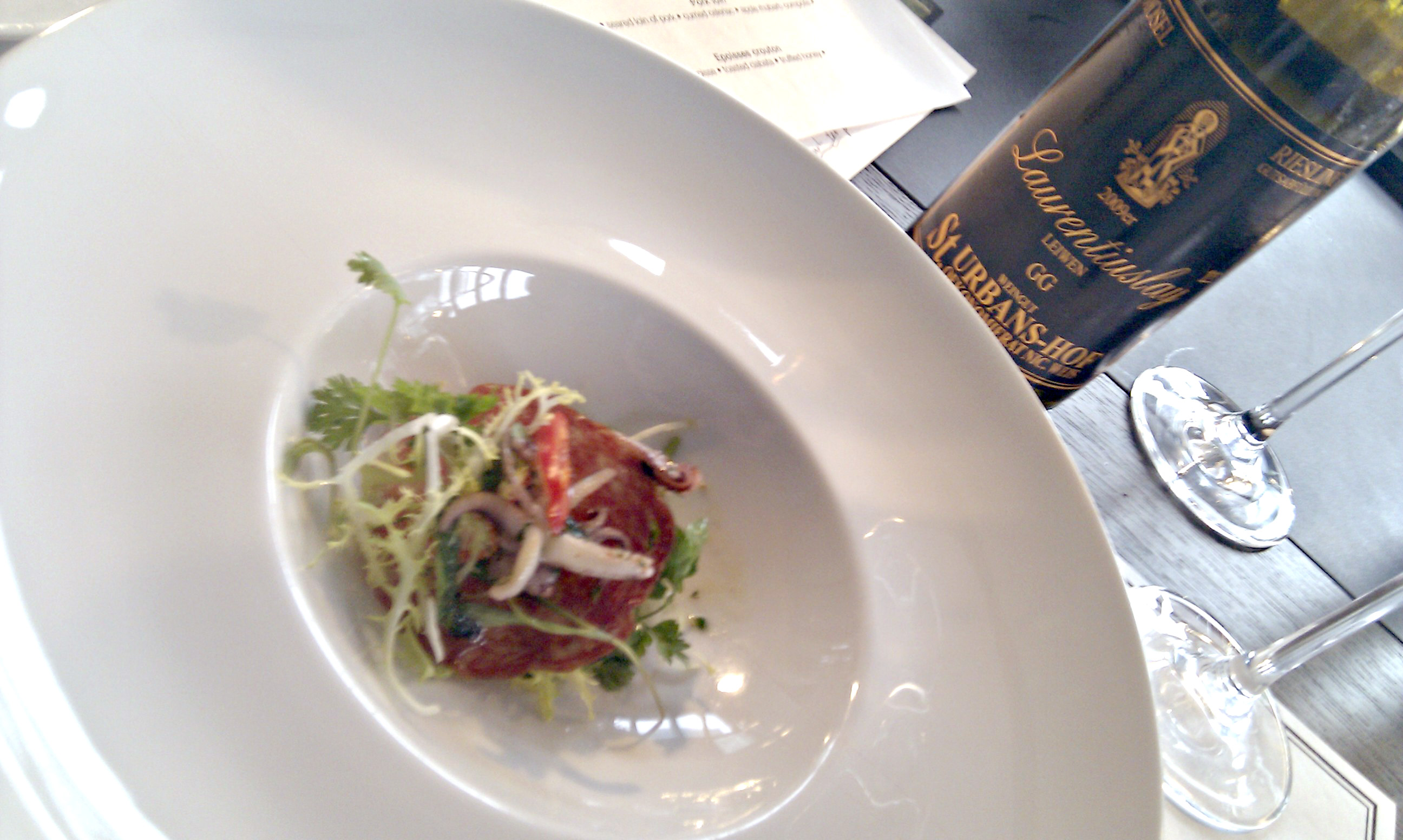
Apart from contrast vs. complement we found that there is another way of looking at food and wine pairing that can lead to different approaches. Should the wine make the food shine, or maybe the other way around? In this context it was interesting to hear experiences from different panel members with regards to the tuna. Laurent really enjoyed the 2007 Laurentiuslay Spätlese because the minerally (samphire) and savoury components of the dish emphasized the wine's fruit definition. Christine on the other hand was surprised that the dry 2009 Laurentiuslay Grand Cru made the dish appear sweeter than it actually was, because of the fattiness of the tuna rounding out the wine's acidity. We also noted that the smoky trout, or smoky food in general, makes fruit in wine appear less prominent, something from which drier wine can suffer.
A German wine label is one of the things life's too short for – Kingsley Amis
During our discussion of German wine almost inevitably the issue of labels and perception came up. In this context I should probably add that we meant actual wine labels. The things estates put on the bottle. This was an important topic for Nik, who asked us the question that will probably go through the head of every German winemaker who cares about the export market: are my labels stopping me from selling as much as I could otherwise? Are German wines at a disadvantage against, for instance, New World wines with their funky names in languages English speakers can actually understand and pronounce?
While we were discussing this, I noticed that my perspective somewhat differed from that of other panels members. The sommelier and restaurant people felt that German labels can indeed be a bit daunting, that names were difficult to pronounce, classifications hard to understand and that some labels contained too much information – at least for some of their customers.
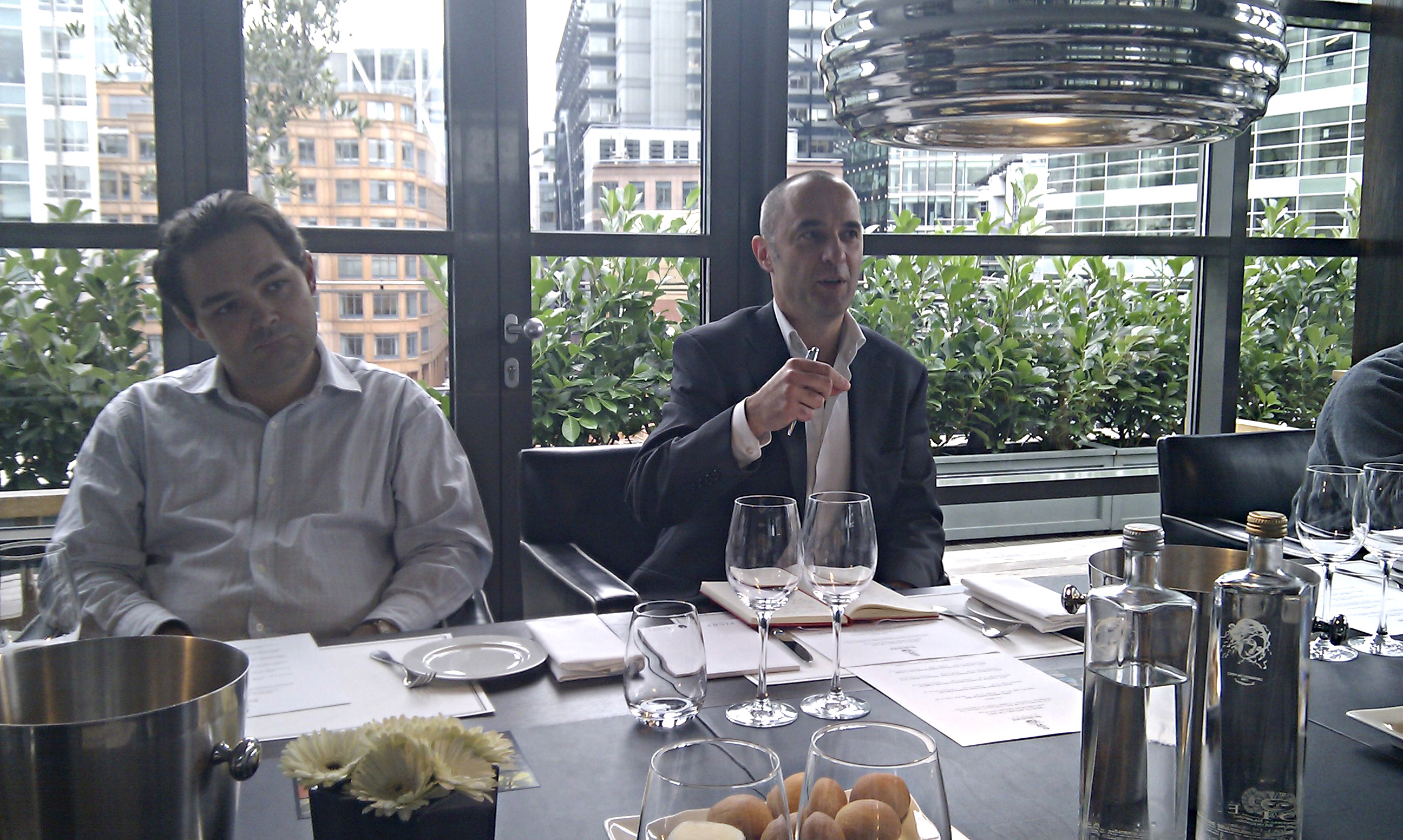
After some consideration, I made the argument that the label was not the main issue, image was. People may not understand German wine labels, but do they really understand French labels? How many customers know what Chablis is or what quality system Bordeaux operates? Wine enthusiasts would know, but they also tend to have an idea what 'trocken' or 'Spätlese' mean.
I do believe that on a mass market people buy French wines because just by growing up in England they inevitably get the idea that it is a sign of quality. James Bond orders a Claret, so if you see one in a supermarket in a price range you can afford you may go for it - and it does not matter that you don't understand the information on the label or that it is neither shiny nor concise or modern. French wine is seen as classy, so it can have complex labels, I argued – in fact, these labels may even enhance the perception of the wine as a complex, desirable good.
The image of German wine in UK popular culture is vastly different. Overall It is one of cheap, sweet white wines, wines that sell for just a few quid at ASDA, amongst other simple wines. This is no problem for brands like Blue Nun because they compete in lower price ranges where customers would not expect a fine Bordeaux. They keep the labels simple, because they sell simple wines. In the more expensive range you will also find simple wine labels, but here it is much more about the style of the respective estate and its brand. I am not sure that more complex labels are by default a disadvantage in the premium range.
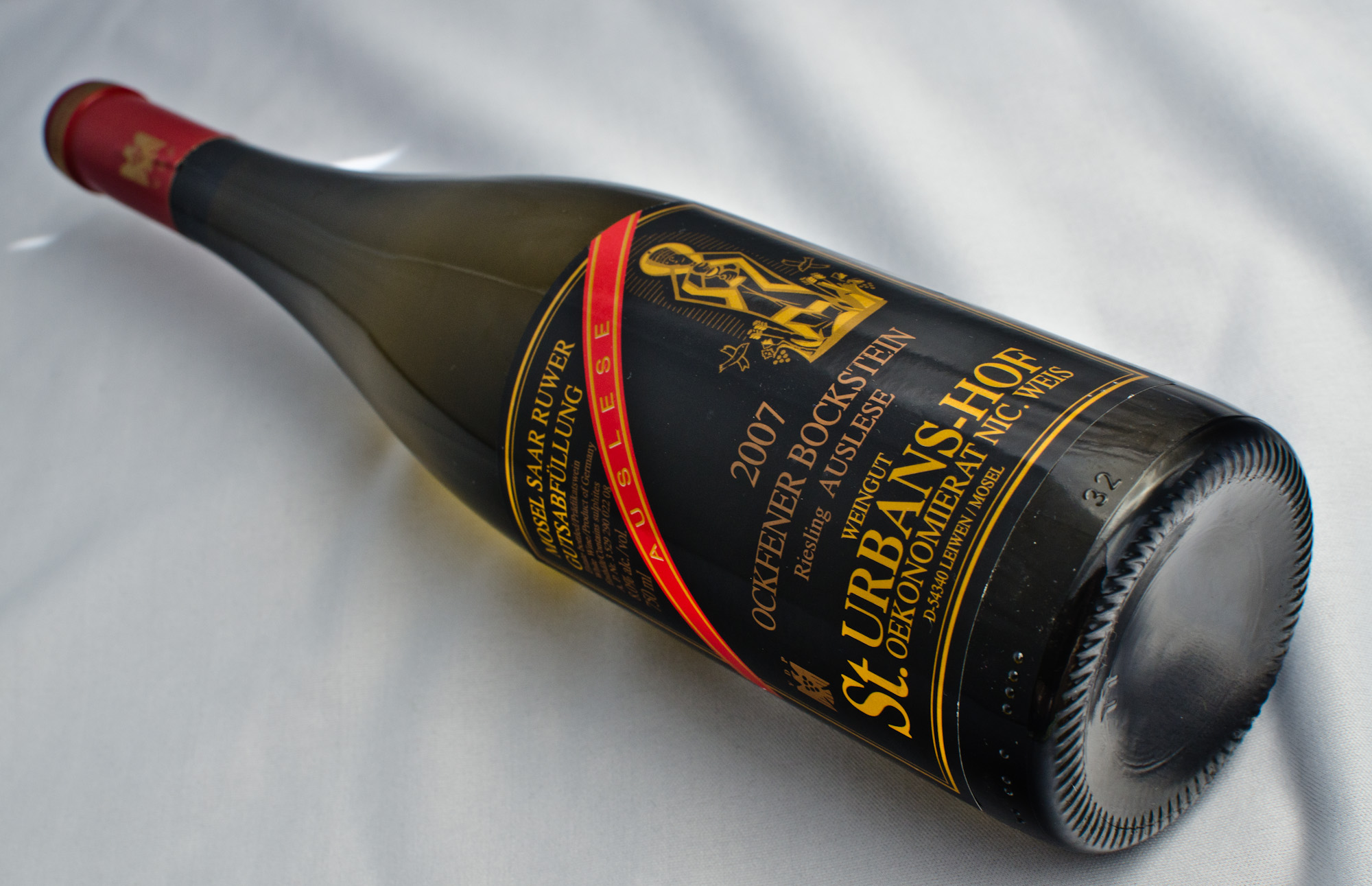
Admittedly, language is a problem. Otherwise German labels are actually very helpful to understand the wines. You will usually find out which region the wine is from, what grape variety, alcohol level, vintage, winery and whether the wine is dry, sweet or off-dry; you may also find the name of the vineyard and the quality level. If you can read and place that information, it is very helpful – again, connoisseurs will appreciate it. Others would not, but I am not convinced they would buy premier German wine anyway.
One way out of the language problem would of course be to have mid-range wines that are specifically marketed for export into English speaking countries. Some estates do seem to do that with much success. Josef Leitz exports wines with simple labels and names like 'Leitz Out' or 'Eins, Zwei, Dry' - especially the latter I find a very clever pun, using one of the German phrases many Brits will have heard of and adding the information that the wine is dry. The Haart winery sell a wine called Haart to Heart. And so on. This seems to work quite well in the mid-range market. Is it the right approach for higher quality/price wines though? Will the 'average customer' even note that these wines exist, will it change the perception of German wine as sweet plonk?
Beasting off the Riesling
How do you change that perception? How do you restore 'Mosel' to the brand it was a hundred years ago, when German Rieslings were the most expensive and sought after wines in the world, asked Nik. While I have spent much time to work for the German wine brand on an individual level, Robert as a brand ambassador (for Spanish wine) had much useful information to share on (mass) customer perception and how to change it. The short summary is that unless you have a hell of a lot of resources, you may not succeed, or you will have to measure your progress in small steps.
This reminded me of one line of text that probably did much more for Riesling sales than many marketing campaigns: 'And I'm beasting off the Riesling'. At some point last year I noticed that the subject of Riesling had suddenly become very popular on Twitter, and lots of – judging from their avatars – cool, young, black Americans were busy all the time 'beasting off the riesling'. What had happened?

Hip hop artists Jay-Z had released a song, featuring Rihanna and Kanye West, that included the above mentioned line. Suddenly, Riesling was cool, at least among a certain strata of the US population. You can still see the effect of this, just search Twitter or the internet for that phrase. The posting I wrote about 'Beasting off the Riesling' is still one of our most visited pages here at the Wine Rambler.
Does this have an effect on the premium market though? Judging from their Twitter presence, many Americans who quoted that line did not appear to care very much about wine or to buy premium wines. In fact, the Riesling line I see most on 'US' Twitter is quite revealing in that context: 'Riesling or Moscato tonight?' The brand that is mentioned most is 'Relax Riesling' – also hardly a premium wine. Its slogan is 'No complicated names and labels. Just great wine.' Again, I think, this is not the market in which winemakers like Nik would, should or could compete.
Still, these brands can help to familiarise people with the idea of drinking German wine. Also, they can command relatively big marketing machines that can have some impact on the market. Black Tower for instance are well known in the UK because they spent quite a lot of money, and they worked hard to create a distinctive brand. I am not so sure I agree that the image they have chosen reflects what I enjoy about German wine though.
It seems at least for the time being the man with the tastiest Riesling wardrobe in London will not find much support from the marketing campaigns of the big brands...
Sweetness is your friend
What all panels members seemed to agree on was that in the market estates like St. Urbans-Hof are interested in, working with restaurants is a good way of raising the profile of Riesling. In this context, the workshop has clearly demonstrated how versatile Mosel Riesling can be with food, and, to quote Stuart Pigott, that sweetness is your friend.
Appendix
* Whose second name I sadly did not get.
** Photos by Robert McIntosh; all licensed CC by-nc-sa; as I used two of the photos for the collage at the top, this image is obviously also available under that license.
*** St. Urbans-Hof wines are available in the UK through www.thewinebarn.co.uk
**** Kanye West and Jay-Z, photo by Mike Barry, licensed CC 2.0, attribution

St Urbans-Hof Riesling Tasting
Great blog article. Unfortunately, I was unable to attend this one, even though I was invited by Walter. Looked very interesting. I went to the vertical tasting of St Urbans-Hof Rieslings on the following day. There is a blog article on my website www.robertgiorgione.com
Save the Date: Monday January 24th "Ravenous For Riesling" - an exciting blind tasting of 75 Rieslings from around the World. This will be the first @rovingsommelier "Pop Up Wine Tasting". Twitter hashtag #RavenousForRiesling.
Looking forward to seeing you there @robertgiorgione
In reply to St Urbans-Hof Riesling Tasting by Robert Giorgione
Re: St Urbans-Hof Riesling Tasting
Thanks for your comment, Robert. It was a fantastic event, and as you have already tried the St Urbans-Hof wines I don't have to tell you how good they are. Your Ravenous for Riesling tasting is already in my diary and I look forward to seeing you there!